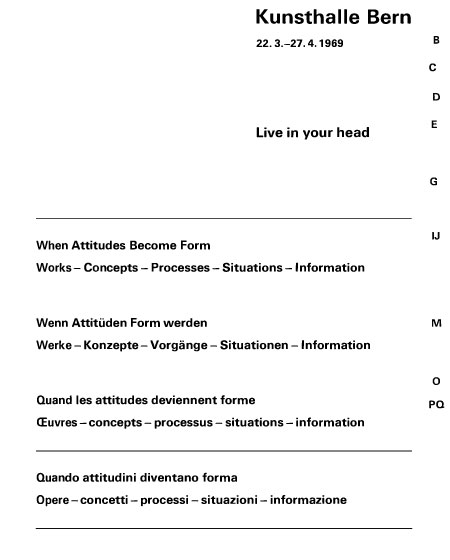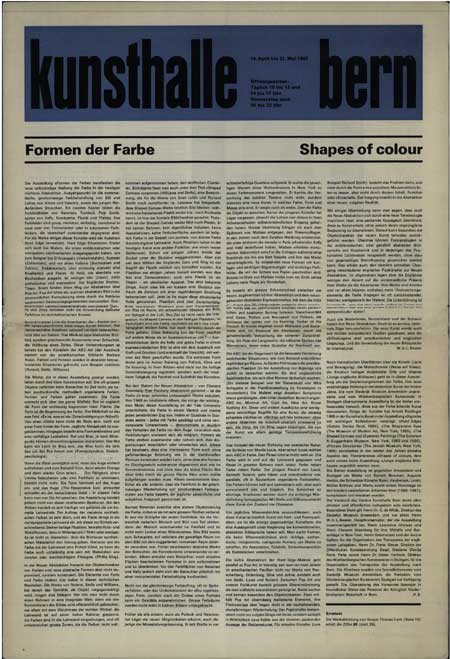

|
 historical historical
 ubuweb ubuweb
|
Harald Szeemann | Switzerland (1933-2005) 
 Live In Your Head: When Attitudes Become Form: Works-Concepts-Processes-Situations-Information (1969) [PDF, 86mb] Live In Your Head: When Attitudes Become Form: Works-Concepts-Processes-Situations-Information (1969) [PDF, 86mb]
Catalogue from the 1969 exhibition at the Kunsthalle Bern, curated by Harald Szeemann. ""'When Attitudes Become Form' marked the end of a decade of extremely fertile innovation and experimentation that had great influence on the visual arts. In short order Pop art and Fluxus, Minimalism and post-Minimalism, Conceptual art, Land art and Arte Povera transformed the discourse on the nature of art and its materials, questioning how and by whom a work of art can be made, where a work of art can exist, and even whether it needs to exist as an object at all."(Christian Rattemeyer, Exhibiting the New Art, Afterall 2010) 
 Formen der Farbe (1969) [PDF, 47mb] Formen der Farbe (1969) [PDF, 47mb]
Kunsthalle Bern .:. --> VERKAUFT! [Kunsthalle Bern] Formen der Farbe = Shapes of colour. Bern: Kunsthalle, [1969]. 26 Seiten mit Abbildungen. Zeitung. Folio. 214, Ausstellung 14. April bis 21. Mai 1967. - Falten leicht berieben, gestempelt. Harald Szeemann (June 11, 1933 in Bern – February 18, 2005 in Tegna, Ticino) was a Swiss curator and art historian. After studying art history, archaeology and journalism in Bern and Paris, Szeemann began working in 1956 as an actor, stage designer and painter, and also did one-man shows. He started creating exhibitions in 1957. From 1961 to 1969 he was curator of the Kunsthalle Bern, where he organised in 1963 an exhibition of works by the "mentally ill" from the collection of the art historian and psychiatrist Hans Prinzhorn, and in 1969 the legendary exhibition "When Attitudes Become Form". In 1968 he gave Christo and Jeanne-Claude their first opportunity to package an entire building: the Kunsthalle. After leaving the Kunsthalle he founded the "Museum of Obsessions" and the Agentur für Geistige Gastarbeit ("Agency for Spiritual Migrant Work", from Gastarbeiter, "migrant workers"). In 1972 he was the youngest artistic director at documenta 5 in Kassel. He revolutionised the concept: conceived as a hundred-day event, he invited the artists to present not only paintings and sculptures, but also performances and "happenings". From 1981 to 1991 he was the sole curator of the Kunsthaus Zürich, and in 1980 he co-hosted the Venice Biennale, where he created the Aperto exhibition for young artists. He was among the few to curate the Biennale twice, in 1999 and 2001. He also curated the international exhibition Einleuchten, the inaugural exhibition at the Deichtorhallen in Hamburg, in 1989. In 1982 Szeemann commissioned a three-dimensional reconstruction of Kurt Schwitters's Hannover Merzbau (as photographed in 1933) for the exhibition 'Der Hang zum Gesamtkunstwerk' in Zurich in 1983. It was built by the Swiss stage designer Peter Bissegger and is now on permanent display in the Sprengel Museum in Hanover. Szeemann played a key role in shaping the architecture faculty (Accademia di Architettura) at the Università della Svizzera italiana, the first university in Italian Switzerland, for the first six years after its founding in 1996. From 1961 he belonged to the artists' group Collège de 'Pataphysique', from 1997 he was a member of the Akademie der Künste in Berlin, and in 2000 he was awarded the Max Beckmann Prize. Szeemann was married to the artist Ingeborg Lüscher, and lived in the village of Tegna in Ticino, Switzerland. Szeemann invented the modern-day Großausstellung ("great exhibition"), in which the artworks are tied to a central concept and are assembled into new and often surprising interrelationships. His over 200 exhibitions were distinguished by a great abundance of material and a broad range of themes. Important reference points were subversiveness, alternative lifestyles (for example Monte Verità), and the Gesamtkunstwerk ("total artwork", Wagner's concept of a work which spans all the arts), to which his own exhibitions, in a certain sense, were also indebted. - Wiki |